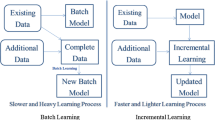Abstract
Face detection technology has been a hot topic in the past few decades. It has been maturely applied to many practical areas. Therefore, introducing an outperforming model is needed. Nevertheless, the proposed algorithms do not alter with the dynamic aspect of data and result in a high computational complexity. This paper expounds on how to promote the face detection rate from complex pictures by the means of one-class incremental learning strategy, while using low variance directions to project data. In fact, it has been shown that taking into account the information carried by low variance direction may improve the accuracy of the model in one-class classification problems. Besides, incremental learning is known to be compelling, especially in the case of dynamic data. A comparative evaluation of the proposed approach is performed in a decontextualized evaluation framework. Then a contextualized evaluation is conducted to show the effectiveness of the approach in the context of face detection.



Similar content being viewed by others
References
Semwal, V.B., et al.: Design of vector field for different subphases of gait and regeneration of gait pattern. IEEE Trans. Autom. Sci. Eng. 15, 104–110 (2016)
Semwal, V.B., et al.: An optimized feature selection technique based on incremental feature analysis for bio-metric gait data classification. Multimed. Tools Appl. 76(22), 24457–24475 (2017)
Rathee, N., et al.: An efficient approach for facial action unit intensity detection using distance metric learning based on cosine similarity. Signal Image Video Process. 12(6), 1141–1148 (2018)
Yang, M.H., et al.: Detecting faces in images: a survey. IEEE Trans. Pattern Anal. Mach. Intell. 24, 34–58 (2002)
Laskov, P., et al.: Incremental support vector learning: analysis, implementation and applications. J. Mach. Learn. Res. 7, 1909–1936 (2006)
Khan, N.M., et al.: Covariance-guided one-class support vector machine. Pattern Recognit. 47, 2165–2177 (2014)
Kefi, T., et al.: Human face detection improvement using incremental learning based on low variance directions. In: ACIVS, pp. 170–179 (2017)
Semwal, V.B., et al.: Human gait state prediction using cellular automate and classification using ELM. In: MISP (2017)
Alotaibi, A., et al.: Deep face liveness detection based on nonlinear diffusion using convolution neural network. Signal Image Video Process. 11(4), 713–720 (2017)
Farmanbar, M., et al.: Spoof detection on face and palmprint biometrics. Signal Image Video Process. 11, 1253–1260 (2017)
Vong, C., et al.: Fast and accurate face detection by sparse Bayesian extreme learning machine. Neural Comput. Appl. 26, 1149–1156 (2015)
Boroujeni, H.S., et al.: Robust moving shadow detection with hierarchical mixture of MLP experts. Signal Image Video Process. 8, 1291–1305 (2014)
Mygdalis, V., et al.: One class classification applied in facial image analysis. In: 2016 IEEE International Conference on Image Processing, ICIP 2016, pp. 1644–1648, Phoenix, AZ, USA, September 25-28 (2016)
Özbeyaz, A., et al.: Familiar/unfamiliar face classication from EEG signals by utilizing pairwise distant channels and distinctive time interval. Signal Image Video Process. 12, 1181–1188 (2018)
Tan, C., et al.: Semi-supervised incremental feature extraction algorithm for large-scale data stream. Concurr. Comput. 29, 6 (2017)
Losing, V., et al.: Incremental on-line learning: a review and comparison of state of the art algorithms. Neurocomputing 275, 1261–1274 (2018)
Labusch, K., et al.: Simple incremental one-class support vector classification. pattern recognition. In: 30th DAGM Symposium Munich, Germany, pp. 21-30 (2008)
Davy, M., et al.: An online support vector machine for abnormal events detection. Signal Process. 86, 2009–2025 (2005)
Chongming, W., et al.: Fast incremental learning algorithm of SVM on KKT conditions. In: Sixth International Conference on Fuzzy Systems and Knowledge Discovery, pp. 551–554 (2009)
Hager, W.W.: Updating the inverse of a matrix. In: SIAM Review. A Publication of the Society for Industrial and Applied Mathematics, pp. 221–239 (1989)
Hua, X., et al.: Incremental learning algorithm for support vector data description. J. Softw. 6, 1166–1173 (2011)
Myint, H.O., et al.: Incremental learning algorithm based on support vector machine with mahalanobis distance (ISVMM) for intrusion prevention. Int. Conf. Electr. Eng. Electron. Comput. Telecommun. Inf. Technol. 2, 630–633 (2009)
Tax, D.M.J.: DDtools, the Data Description Toolbox for Matlab, version 2.1.2 (2015)
Frischholz, R.W., et al.: BioID: A multimodal biometric identification system. IEEE Comput. Soc. Press 33(2), 64–68 (2000)
Phillips, P.J., et al.: The FERET database and evaluation procedure for face-recognition algorithms. Image Vis. Comput. 16(5), 295–306 (1998)
Vidit, J., et al.: FDDB: A benchmark for face detection in unconstrained settings, UMass Amherst Technical Report (2010)
Zafeiriou, S., et al.: A survey on face detection in the wild: past, present and future. Comput. Vis. Image Underst. 138, 1–24 (2015)
Chang, W.C., et al.: A revisit to support vector data description. National Taiwan University of Science and Technology, Taipei, Taiwan, Technical Report (2015)
Author information
Authors and Affiliations
Corresponding author
Additional information
Publisher's Note
Springer Nature remains neutral with regard to jurisdictional claims in published maps and institutional affiliations.
Rights and permissions
About this article
Cite this article
Kefi-Fatteh, T., Ksantini, R., Kaâniche, MB. et al. Human face detection improvement using incremental learning based on low variance directions. SIViP 13, 1503–1510 (2019). https://doi.org/10.1007/s11760-019-01498-1
Received:
Revised:
Accepted:
Published:
Issue Date:
DOI: https://doi.org/10.1007/s11760-019-01498-1




